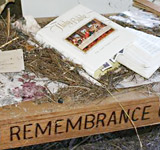Miracle Farm offers refuge to Hurricane Rita evacuees
Posted: 9/01/06
| Miracle Farm residents display a mirrored tile that was presented as a gift to the Texas Baptist child care ministry by the Little Cypress-Mauriceville Bears. (Photo by Courtney Cole) |
Miracle Farm offers refuge
to Hurricane Rita evacuees
By Courtney Cole
Miracle Farm
BRENHAM—When Hurricane Rita struck southeastern Texas, residents of communities near Orange found shelter from the storm at Miracle Farm. And everyone involved believed the provision was a miracle—or at least a divine appointment.
“We had extensively planned and were prepared to minister to families that had been displaced by this catastrophic storm,” said Jack Meeker, executive director of Miracle Farm, a childcare agency for boys operated by Children at Heart Ministries. “We soon realized that God had hand-picked a special group to be directed into our circle of care.”
Steve Griffith, coach of the Little Cypress-Mauriceville Bears baseball team, agreed.
“Finding a place to go wasn’t hard, because it was meant to be,” he said.
The team and their families searched and prayed for a safe place to flee as Hurricane Rita turned their town upside down. Griffith believes God responded by directing him to Brenham’s high school baseball coach, Jim Long, who referred him to Miracle Farm.
“It became clear that as we were looking for someone to help us, they were looking for someone to help,” Griffith explained.
Within a few days, 70 people relocated to their new home in the Miracle Farm Retreat Center bunkhouses. They shared meals with staff and residents.
“For more than two weeks, our staff and boys had the unique privilege of hosting and ministering to these special guests,” Meeker said. “Our prayer was that Miracle Farm could not only provide a safe haven, but that they would also experience an outpouring of God’s love while they were with us.”
Individuals and churches from Independence Baptist Association helped by contributing groceries, preparing and delivering meals, giving financially and collecting personal care items, paper goods, linens and pillows.
“We are truly thankful for each person who helped make this special group’s stay not only meaningful and comfortable, but also confirmed that God is working through his people,” Meeker said.
The displaced Golden Triangle residents responded by helping out with campus projects, giving back financially and encouraging the boys at Miracle Farm.
“The great people at Miracle Farm went above and beyond the call in an outstanding way to care for us like we were family,” Griffith recalled. “We have established many friendships that will last a lifetime.”
His wife, Lana, added: “Never in my life have I experienced such an outpouring of concern and Christian love than what we received during our stay … by the staff, the residents and the community. Our family is forever changed and grateful. We feel blessed to call you all friends.”
Griffith’s baseball team returned to Miracle Farm several months later while traveling to a tournament.
They presented the children’s home with a mirrored tile as a token of appreciation.
Miracle Farm benefited from its ministry to the storm victims, Meeker said.
“We thank Coach Griffith for trusting us to touch the lives of those closest to him,” he said. “They all touched our lives as well in ways we will always remember.”
